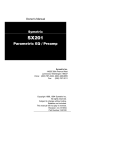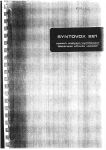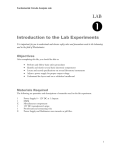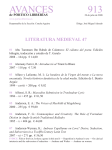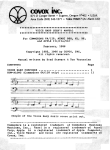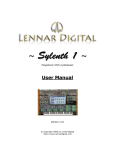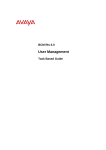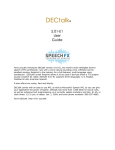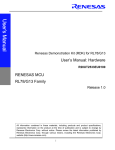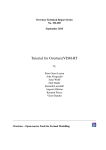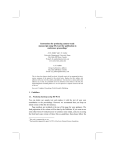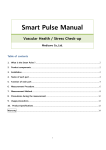Download REAKTOR USER ENSEMBLES v.02B
Transcript
REAKTOR USER ENSEMBLES
v.02B
Collected by Simon Hunt – March 2008
click the blue
BEAT SEQUENCERS
rhythm-making machines, with or without onboard
sequencers. Some load audio files, some create sounds via
synthesis
EFFECTS
Effects to add to your audio tracks or instrument tracks
SAMPLERS – BASIC
Instruments to load your audio files into
SAMPLERS – GRANULAR
More complex samplers that create textures from your audio
files
SYNTHESIZERS – EMULATION
Synthesizers that emulate either classic hardware
synthesizers or particular musical instruments
SYNTHESIZERS – OTHER
Other synthesizers
BEAT SEQUENCERS
TERMINAL GLITCH
By Dean Lowe
Terminal Glitch is a 4 track Percussion/Melody Sequencer especially designed for
IDM and Glitch music, although it can be used for any sort of music you like.
It features 4 Oscillators each with dedicated Gate Sequence and Filter section. A
global pitch sequence (scale sequence is a more suitable name) with a list of
predefined scales to choose from and a user definable scale which is capable of
microtonal scales. Automatable faders (some dedicated, others assignable) and a
repeater section based on Exile's Glex module. The sequencers also feature
controllable step randomization.
Please click on the 'B' view for further utilities and a small user manual covering
some of the more complex operations.
Play Protools to start the sequencer.
EFFECTS
EchHase
By Dieter Zobel
Delay effect with multiple feedback paths.
KOHRUSS
By Dieter Zobel
“abused pitchshiphtor” (sic).
Phase / flange / delay with good feedback options and random detune field.
LASERBREW
By Tim Schwerdtfeger
the other side of reverb
Laserbrew is a totally new approach to reverb effects and doesn´t try to
simulate the reflections of a real room - it´s actually based on a physical
model of a damped string and went the PSP PianoVerb way but it now
goes far beyond that: It´s able to produce everything from lush organic
washes to resonant modulated outta space effects.
Great for everything special, no matter whether it´s electronic or acoustic.
It´s quite a CPU hog, so be careful. Check preset 04 – piano
LILTHREE
By Tim Schwerdtfeger
"lilthree are three little macros that process stereo audio data.
the first one called 'AM' is a simple but useful amplitude modulation
macro which does well-known tremolo effects with adjustable speed
and intensity. it can operate at audible frequencies and therefore i
implemented an alternative ringmodulator-mode.the second macro
('FM') does something that is not so well-known: frequency
modulation with external audio signals. the special thing is: the audio
input doesn´t modulate a built-in oscillator, the oscillator will modulate
the audio material! weird but not so strange effects are the result because
the audio-input stays recognizable.
the third and biggest one is called 'Rotation': it is able to rotate every
audio input within stereo field but without any loss of stereo
information! it´ll be quite new for most users, but give it a try, it´s
really nice for animating static sounds within the mix or fuzzy stereo
modulation at higher rates.
four waveforms per effect to choose from
Preset 5 Stereo rotation is great for livening up dull mono or stereo material
MAGMA
By James Clark
(self-generating rather than an effect)
Magma flow - hot stuff
Something to annoy your neighbors with. A silly (but note the cool plasma
displays) little ambient gurgler dedicated to my cranky bathroom
plumbing which periodically makes a mess.
MICHAT´S MULTIHEAD TAPEECHO
By Michael Wöstefeld
Tapeecho simulation (Space Echo)
Tapeecho simulation with four playback heads, tape simulation & drive
error simulation
MICHAT´S DRONE ECHO
By Michael Wöstefeld
Echo with unlimited feedback possibilities
The DroneEcho DE- P01 is a delay based on diffuser delays. You will be
able to do dubeffects without distorting the feedback.
Preecho->input diffusion->main echo
including "tape noise", "tape error" and feedback "shape"
Input filters serial or parallel
syncable delay
cross-feedback
RESONATTER
By Dieter Zobel
synth/resonator effekt
resonator effekt/synth,
should be feeded with an audio signal.
Der freundliche Nager wird es Dir danken.
* Extraordinary resonator, try preset 012 ‘und struppi’ and 03 ‘an der
seite’.
TRAVEL LISA
By Dieter Zobel
“granular toy,
suitable for children”
Deep granular (de)composer! Feed audio to it, choose presets , Click and
drag the mouse within the fields, move the buttons at the base and the
right. Click the structure button to have a look inside.
SYNTHESIZERS – EMULATION
21st CENTURY THEREMIN
By Joel Kruse
This is a fake theremin with a few extras. There are 2 control modes:
mouse mode and midi mode. Low CPU usage.
Use your mouse in the X-Y field, change oscillator types at right.
http://en.wikipedia.org/wiki/Theremin
HALLELUJAH
By Martijn Zwartjes
Church Choir Simulator
Using 7 sawtooths and 4 SVF Filters.
LUNCHBOX-303
By eige kitamura
an emulation of the Roland TB-303 (1982)
“new kitchen techno setup”
Extensive instructions within the ensemble itself.
http://en.wikipedia.org/wiki/Roland_TB-303
Press play on Protools and choose presets to start.
MINIMOOD R5
By Jonathan Style
an emulation of the monophonic analogue Minimoog (1970)
Extra FX windows at base.
Keyboard on GUI doesn’t work.
http://en.wikipedia.org/wiki/Minimoog
MONA/POLLY
By James Clark
I did my best to come up with a synth that gives some sense of the sonic
insanity of the Korg Mono/Poly (1981). There are a lot of differences,
thus I call it a parody rather than an emulation! The poly mode is not
quite right, and the Share mode is not even close. The sound of the filter
is wayyy off. And there is a problem with the snapshots. Changing one
snapshot can affect others, and some things don't seem to saved
correctly.
http://en.wikipedia.org/wiki/Korg_mono/poly
I split my Mona/Polly synth into two views - A: left half of panel, B:
right half of panel. I guess switching between A/B views is better
(faster) than scrolling.
Simon Hunt’s note :
Until I manage to stick an updated version in the ensembles folder, do the
following :
- go to OUTPUT section and flick switch from “off” to “high”
- go to Structure View and connect the output to “2” as well, so
that you hear the right channel.
MX-20 Bassline
By James Clark
Vanilla bassline seq with new core filter
Nothing special here, but I was fooling with the core and came up with a
new filter, loosely modeled after the Korg MS-20. Added the Plasma
sequencer borrowed from the prolific Steven V. And a delay. Which you
can turn off.
Some of the presets will cause an overload on startup for some reason.
Press play on protools to start.
SEHKTAR
By James Clark
Physically modeled Sitar
Sounds pretty good to my ears, especially at high sampling rates (tip: for
any physical model use as high a sampling rate as your computer can
handle). If it sounds out of tune, it is due to your Westernized ears!
FULL MANUAL at end of this document
SIXTEEN
By Chet Singer
String machine with sixteen oscillators
This is a basic string machine that creates thickness by stacking sixteen
oscillators instead of using a chorus.
Eight of the oscillators can be tuned one octave lower.
The SpaceMaster reverb is included to provide ambience.
Graphic control elements are by Vera Kinter at www.artvera-music.com,
and supplied by Bernd Keil.
WHACK IT
By Chet Singer
Waveguide physical model of a slap bass
This is a physical model of a slap bass, containing a pair of waveguide
strings which can hit a fret and buzz when struck hard enough.
The snapshots included in this instrument have been tuned for use with
44.1 kHz sample rate. Other sample rates may require retuning using the
controls available on the “String” page.
The graphic control elements were created by Vera Kinter, URL
http://www.artvera-music.com.
Some of the controls are self-explanatory, such as Tune, Transpose, Pitch
Wheel Depth, and Output level.
“Number of Strings” can be set to either 1 or 2. When set to 1, legato
playing can create clicks, and can also build up significant energy in the
string, making it more likely to hit the fret. While this may be undesirable
when playing a straightforward bass, it can add some nice body to the
sound when playing a snapshot that whacks the fret heavily.
There are seven parameter pages: Thumb, String, Slap Fret, Pickups, 10band EQ, Compressor, and Modulations:
Thumb:
This is the initial excitation of the string, and consists of a short burst of
filtered noise. An attack/decay envelope generator controls the
excitation’s shape, and a 1- or 2-pole lowpass filter controls the
brightness. The Strength control determines how much energy is applied
to the string. The pluck point can be moved along the string, or can be
turned off. If turned off, the model resembles a Karplus-Strong string.
String:
The string is a standard waveguide model. The decay time and highfrequency loss are controlled by the Sustain and Tone controls. The
Release control determines how long the string rings when a note is
released. The sustain, tone, and pitch can be adjusted at every fourth
semitone (C, E, and G#). These adjustments are useful when
programming sounds that remain musical over a wide range of notes.
They can also compensate for the tendency of waveguide models to go
flat on high notes. Please note that changing the Tone control may make
the string go flat or sharp, and require re-tuning.
Slap Fret:
This is a fret, which when hit by the string, causes the string’s energy to
reflect back in the direction it came from. Parameters include the fret’s
position on the fret board, the fret’s distance from the string, and the
reflection’s gain. The distance between the fret and the string determines
how easily the fret will be hit. A lamp indicates when the string and fret
are in contact. A switch can disable the slap fret. To make an expressive
slap bass, route key velocity to Thumb Strength, and adjust the distance
between the fret and the string.
Pickups:
This is the output of the model. Three outputs are provided: an acoustic
pickup at the bridge, a movable electric pickup, and the initial thumb
excitation impulse.
10-Band EQ:
The 10-band equalizer is the standard Reaktor equalizer, stripped to a
single mono channel. There are also two additional filters. The first is
called Big Bottom, which tracks and emphasizes the note’s fundamental
frequency. The second is called an Acoustic Filter, and is an array of
bandpass filters that mimics the resonances in a string bass.
Compressor:
The compressor is the standard Reaktor compressor, stripped to a single
mono channel.
Modulations:
MIDI modulations are programmed here. Six busses are provided. Each
bus has a source, destination, curvature, modulation amount (both
positive and negative) and on/off switch. Sources are various MIDI inputs
(mod wheel, velocity, etc.). Destinations are various parameters of the
model (attack time, thumb strength, fret position, etc.).
SYNTHESIZERS – OTHER
BABBLE ON
By James Clark
3 voice speech synthesizer
The Babble_On ensemble comprises three Speech Synthesizer
instruments with snapshot based sequencing. The ensemble can store up
to 16 songs, each of which can be made up of up to 128 patterns of up to
16 phonemes each.
The speech synthesizer can generate 29 distinct phonemes. Some
additional phonemes can be generated by concatenating the provided
phonemes. The pitch of the synthesized voices can be adjusted over a 5octave range. A pattern-specific transposition is available for each
voice, which adjusts the pitch and shifts the vocal formants, allowing a
wide range of different voice qualities (male, female, etc) to be generated.
Press play on Protools and listen to “Are you lonesome tonight”
FULL MANUAL at end of this document
CLUSTER 16
By James Clark
Cluster Pad Synth
Cluster 16 came about after swapping out oscillators in Chet Singers'
Sixteen string synth. I added a Chorus and took out the filters. One thing
led to another and a completely different synth evolved. I added FM
modulators to control the four banks of oscillators with Rick Scott's
Randomation to randomize their values. To best experience the effect of
the randomizers, hold a note for a long time. All included snaps are with
the randomizers ON, but if you find a sound you like, just turn them off.
Mach II version has more wave options and reintroduced filter. Sounds
like the original with all set to sine and filter OFF. Added snaps
DRIFTWOOD ARPEGGIATOR
By James Clark
Complex arpeggiator
A complex but fun arpeggiator, for those who like things going up and
down and sideways. Combine with your favorite noise maker for hours of
fun. Mouse-over the controls and buttons to get info on how to make it
run. Includes the library synth Carbon for demo.
MICHATS SHINY SYNTHESIZER V1.0
By Michael Wöstefeld
Synthesizer for the twinkle pad sounds
Michats Shiny Synthesizer is designed to produce twinkle pad sounds. It
contains two sections:
On the left the basic section with three "analog" oscillators and a sample
player for the basic pad sound.
On the right the shiny section, which is the same but with a usercontrollable pitch-table and a chorus.
Both sections have all filters with main envelope and an own volume
envelope. For the master there are envelope and lfo plus a delay routable
on pad, shiny or both.
Happy twinkling!
MONO FM
By Stephan V
Monophonic FM Synthesizer
A simple and very CPU-friendly 2-operator-FM-synthesizer for bass and
lead sounds. Quick and dirty.
-
2 operators with feedback, adsr-envelope
2-pole-lowpass filter with adsr-envelope
1 lfo and 1 modulation envelope (ad)
equalizer, chorus and delay effects
32 snapshots
TESLA TONE
By James Clark
Kickbutt lead synth
If Nikola Tesla built synths, maybe he would build something like this one!
I must congratulate NI on doing a wonderful job with their new Transistor
Ladder filter core cell. It sounds lovely...
The 3 large sparking electric zapper thingies are x-y controllers.
This synth contains two complex oscillators, two slaved transistor ladder
filters feeding into a saturating distortion module. The output of the
distortion is fed in to a set of 8 parallel delay line resonators, to provide a
"sympathetic resonance" effect. The frequencies of the resonators are
spread out from a tonic note (which can be fixed, or set to follow the
MIDI Notes) with an adjustable spread. The output of the filters,
distortion, and sympathetic resonators are summed together and passed
to a simple delay/echo unit, and then on to the synth's output. Modulation
is provided by an ADSR envelope generator and a multi-wave LFO, and
can control the filter cutoff frequency and the saturation level.
The complex oscillators consist of a serial chain of 4 sine-wave oscillators,
each modulating the frequency of the next in the chain. Two addition
multi-wave oscillators are added to the middle and end of the chain. The
outputs of the 4 sine-oscillators and the 2 multiwave oscillators are
summed and output.
The user-interface is pretty straightforward. The 3 large sparking electric
zapper thingies are x-y controllers. The left-most controller morphs the
output of the multiwave oscillator in osc1 between TRIANGLE (UpperLeft),
SINE (UpperRight), SAW (LowerLeft) and SQUARE (LowerRight)
waveforms. The middle controller does the same for osc2. The right-most
controller controls the Filter Envelope Modulation amount (vertical axis)
and the Filter resonance (horizontal axis).
The Filter Envelope Mod amount is also mapped to MIDI controller 1 (Mod
Wheel). Filter resonance is mapped to MIDI controller 2, OSC2 waveform
select X-axis is mapped to MIDI controller 3, Y-axis to MIDI controller 4,
and for OSC1 these are mapped to MIDI controller 5 and 6, respectively.
Babble_On – A 3-voice Speech Synthesizer for Reaktor
© JJClark 2005
OVERVIEW
The Babble_On ensemble comprises three Speech Synthesizer instruments with snapshot
based sequencing. The ensemble can store up to 16 songs, each of which can be made up of
up to 128 patterns of up to 16 phonemes each.
The speech synthesizer can generate 29 distinct phonemes. Some additional phonemes can
be generated by concatenating the provided phonemes. The pitch of the synthesized voices
can be adjusted over a 5-octave range. A pattern-specific transposition is available for each
voice, which adjusts the pitch and shifts the vocal formants, allowing a wide range of
different voice qualities (male, female, etc) to be generated.
Song Select – this selects the song to play. It actually switches the snapshot banks
for each of the Babble_On instruments.
2. Song Start/End – these select the pattern numbers (snapshot number) at which song
playback begins and ends.
3. Glide/Transpose/Vibrato – these can be set independently for each pattern. The
transpose both shifts the pitch up or down and shifts the formant frequencies,
modeling the difference in formants for men, women, and children.
4. Lip Reading Display – this shows the mouth shape for the currently playing
phoneme (for the topmost Babble_On instrument).
5. Pattern Number – shows the number of the currently playing pattern (snapshot).
6. Scrollbar – use this to scroll down to the other two Babble_On instruments.
7. Keyboard – use this to set the pitch of the phonemes in the current pattern.
8. Pattern Length – this sets the last step in the displayed pattern. Phonemes after this
point will not be played.
9. Amplitude – sets the amplitude of the phoneme associated with the pattern step.
10. Note Length – sets the length of the associated pattern step.
11. Phoneme Select – chooses the desired phoneme to play. 29 different phonemes are
available.
12. Voice Mixer – set the levels of the 3 individual Babble_On instruments. They can
also be individually muted or soloed.
1.
How to Use
The first thing to understand in using Babble_On is that the sequencer in the
Babble_On instrument is snapshot-based. Different songs (up to a total of 16) are
selected by loading different snapshot banks, one bank to a song.
When you press the START button in the Reaktor toolbar, the pattern selected by
the Song Start slider will be loaded, by selecting the associated snapshot in the
current bank, and the pattern will start playing. The pattern will progress one step at
a time, until the step selected by the pattern’s Last Step slider is reached. At this
point, the next pattern or snapshot (in numerical order) is loaded, and the new
pattern is played. This process continues until the pattern selected by the Song End
slider has been played. When this last pattern has been played, the sequencing stops.
If you want to create your own song, start by using the song select control to select
an unused song bank. Then enter your phoneme patterns, one snapshot at a time,
beginning with snapshot #1. Remember to overwrite the snapshot when you have
entered the phoneme pattern information! Go to the next snapshot by appending the
current one, and enter the new phoneme pattern information. Continue adding
patterns/snapshots until your song is done.
List of Available Phonemes
As in “BEET”
As in “BIT”
As in “BET”
As in “BAT”
As in “BOUGHT”
As in “BOOT”
As in “BOAT”
As in “BUT”
Provides “R” sounds
As in “SHOULD”
As in “SING”
(unvoiced) As in “THIN”
(voiced) As in “THEN”
Some other phonemes can be obtained by combining
certain of the given phonemes:
W – combine the phoneme “OO” with some other vowel. If the W is at the
beginning or middle of a word, place the second vowel after the “OO”
phoneme, otherwise if the W is at the end of a work, place the second vowel
before the “OO” phoneme.
E.g. to produce “WE”, concatenate the “OO” and “EE” phonemes. The
“OO” phoneme should be rather short in duration.
Y – similar to the creation of a W, but use the phoneme “EE” instead of
“OO”. E.g. to produce “YOU”, concatenate the “EE” and “OO” phonemes.
The “EE” phoneme should have a short duration.
CH – Concatenate the “T” and “SH” phonemes.
J – Concatenate the “D” and “ZH” phonemes.
To get the right sound, you need to enter data phonetically, rather
than just spelling out the words.
For example, here is how to enter the phrase “Are you lonesome…”
Note: These phonemes have their amplitudes set to zero, and hence will be
silent. It is still important to set these silent phonemes correctly, as they can
affect the sound of the phonemes before and after. A good rule of thumb is to
set the silent phonemes to be the same as the next vowel to be expressed. The
pitch of the silent phonemes should be set to the pitch of the next non-silent
phoneme, to avoid any undesired glitchy pitch transition.
Sehktar by JJClark (2005)
This Reaktor5 ensemble is
a physical model of a sitar.
Physical Modeling Details
The Sehktar strings are implemented using delay lines with feedback, similar to the KarplusStrong string model. Two delay lines are used for each melody string, to model the horizontal
and vertical vibrational modes of a real string. The amount of detuning between these two modes
can be adjusted with the Mode Detune control. The influence of location of the picking point is
modeled by altering the spectral components of the noise excitation signal. It can be adjusted
with the Pluck Pos control. The overall brightness of the string sound is controlled with a
lowpass filter, and adjustable with the Bright control. The decay rate of the string sound is set by
the amount of energy loss in the string, modeled by a lowpass filter in the feedback loop.
Decreasing the cutoff frequency of the filter results in a greater damping of the string. The
damping of the melody, bass and Chikari strings can be adjusted with their respective Damp
controls.
The nominal pitch of the string sound is set by the delay time of the delay lines. A pitch envelope
raises the pitch slightly, by an amount set by the Penv control, when the string is plucked. This
models the stretching (increase in tension) of the string when plucked.
The unique buzzy sound of the sitar is due mainly to the nonlinear nature of the bridge. The
bridge is curved, which means that the length of the string (and hence its vibrational rate) is
dependent on the amplitude of the vibration. As the string vibrates up and down, its end point
moves back and forth along the curve of the bridge. This bridge nonlinearity is modeled by
modulating the delay line delay times as a function of the string's sound amplitude. The amount
of the nonlinear effect is set by the Jawari control (Jawari is the Indian name for the bridge).
Finally, coupling between the strings is modeled, and is crucial to obtaining the resonant sound
of the sitar. There are two coupling controls, one for coupling between the melody strings and
one for coupling between the melody strings and the sympathetic strings.
Mapping of the MIDI Keyboard to Sehktar Strings and Frets
Plays the Bass string
PDN g M D N R
r g
m d n
middle-C (MIDI note 60)
Mmd n SRGm PnS G SR GMPDN
Range of first melody string Range of Range of third melody string
second
melody string
Strums the chikari (rhythm) strings
Strums the sympathetic strings (usually at the opening and closing of a performance)
Tuning of the Sehktar
The Sehktar has 3 main melody strings, a Bass drone string, 2 Chikari (rhythm) strings, and 11
sympathetic strings (many sitars have 7 melody/drone strings and 13 sympathetic strings).
The first two melody strings are always tuned to notes Ma and Sa from the Indian scale, and the
Chikari strings are always tuned to Sa and Sa one octave up. The tunings of the 3rd melody string
and the bass string are adjustable. For Pancham Karaj, or Ravi Shankar, tuning the 3rd string is
tuned to Pa two octaves down, and the bass string is tuned to Sa two octaves down.For Vilayat
Khan tuning the 3rd and bass strings are tuned to notes depending on the raga being played
(typically the most prominent and next most-prominent notes of the raga). In traditional tuning, the
3rd string is tuned to Sa one octave down, and the bass string is tuned to Pa two octaves down.
The sympathetic strings are tuned according to the particular raga being played, and usually include
all of the notes in the That (or mode) associated with the raga. There are 10 Thats commonly used
in Indian music. The ensemble snapshots give examples of the tuning of the sympathetic strings for
each of these.
Westerners (like me!) might think that the Sehktar sounds out of tune. That is because its frets are
specified so as to give a naturally tempered scale. This type of tuning provides purer harmonic
intervals, which improves the coupling of the sound of the melody strings to the sympathetic strings.
Playing Tips
The Sehktar uses a fair amount of CPU cycles. You can change the Sampling Rate to a
level that doesn't kill your computer. But I urge you to use the maximum possible
sampling rate, as it makes a big difference to the sound. At 44KHz the sound is not too
bad, but the sustain and sweetness of the sound is much improved at 88KHz.
Most of the familiar sitar sound comes from effective utilization of pitch-bending (or
Meend) on the main melody string. Practice makes perfect!
Playing according to the rules of Raga is also important in making the Sehktar sound like
a Sitar. The right notes must be played, and these are different in rising passages than in
falling passages. The sympathetic strings must be retuned according to the raga being
played. If they are not, then the notes of the main melody will not all be sustained and
resonated as they should.
































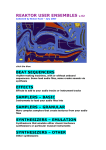
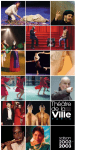

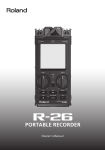
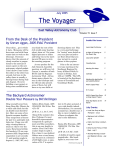
![Deep Time User Manual ver.1.3 [ENG]](http://vs1.manualzilla.com/store/data/005775250_1-8eb61345983a4e3ef84e4b82ef32f1cf-150x150.png)

